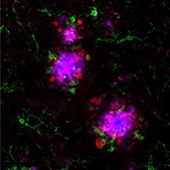CONFERENCE COVERAGE SERIES
Joint Keystone Symposia: Neurodegenerative Diseases: New Insights and Therapeutic Opportunities and Neural Environment in Disease: Glial Responses and Neuroinflammation
Keystone, Colorado
16 – 21 June 2019

At a joint Keystone symposia, microglia continued to twist and turn in the limelight, casting a long shadow as central agents of disease, not mere responders. Researchers embraced the complex reality of mixed pathology, dishing out data from animal models in which Aβ, tau, and α-synuclein mingled and sparked each other’s spread. From a gut-initiated model of Parkinson’s disease to chimeric mice harboring human microglia to a startling conversion of astrocytes to newborn dopaminergic neurons within the brain, researchers upped the ante on disease models and proposed new therapeutic strategies.
TREM2, Microglia Dampen Dangerous Liaisons Between Aβ and Tau
At a joint Keystone symposia, researchers reported how microglia, via TREM2, compress plaques and rein in the pathogenic distortion of neurites into swollen stubs. Without TREM2, these damaged neuronal processes served as fertile ground for tau propagation.
Down to Sex? Boy and Girl Microglia Respond Differently
Microglial responses to Alzheimer’s risk variants, and to tau pathology, appear to show a sex difference. Microglia in male versus female mice use different biological mechanisms to maintain homeostasis.
Dopaminergic Neurons Conjured from Astrocytes Restore Motion
At Keystone, researchers described how directly converting astrocytes into neurons within the mouse striatum restored neuron numbers in a model of PD.
In PD Model, α-Synuclein Spreads from Intestine to Brain
Injecting α-synuclein fibrils into mouse gut sparked the proteopathic spread of misfolded α-synuclein into the brain, where the aggregates killed dopaminergic neurons and caused motor problems.
Do Microglia Finish Off Stressed Neurons Before Their Time?
Using an array of receptors to sense neurons in peril, microglia make matters worse by taking bites out of the struggling cells.
